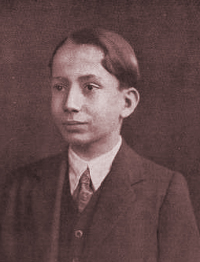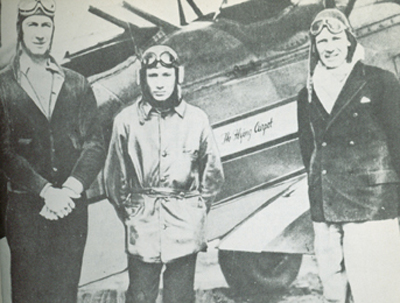
1 FILS COIN - IRAQ - KING OF IRAQ GHAZI I
(KM 102)
Date: A.D. 1938
Obverse: Portrait head left - GHAZI I KING OF IRAQ
Reverse: Lettering - KINGDOM OF IRAQ 1 FILS 1938 - 1357
Engraver: Percy Metcalfe
Top Down: 1. King Ghazi in full regalia 2. As a young man in military uniform 3. As a young boy Right: Prince Ghazi with adventurer Richard Halliburton, his pilot Moye Stephens and their plane 'The Flying Carpet'
Above: Nuri as-Said, Prime Minister under King Ghazi, he served under all the Kings of Iraq. |
This coin was minted for the Kingdom of Iraq (Al-Mamlaka al-Iraqiya), a large oil rich nation in south western Asia. This coin depicts Ghazi bin Faisal, second Hashemite King of Iraq. Born on May 2 1912 in Mecca, he was the only son of King Faisal and his first wife Huzaima bint Nasser. His Grandfather was Hussein bin Ali, Sharif of Mecca, first King of Hejaz. He was born into the royal house of Hashim. The Hashemite are a clan within the larger Quraish tribe who claim to trace their ancestry to the family of the prophet Mohammad. The House of Hashim is a royal family founded by Hussein bin Ali, the Hashemite Sharif (religious leader) of Mecca, who had formerly ruled the Hejaz on behalf of the Ottomans. Hussein bin Ali rebelled against the collapsing Ottoman empire and proclaim himself King of Hejaz and Caliph of all Muslims in 1917, His descendants would rule Iraq and Jordan. Ghazi spent much of his youth with his Grandfather Hussein. By all accounts he was a bright but shy and introverted young man. In 1924, his grandfather was defeated by Saudi forces and driven from Arabia along with his family and many of his loyal followers. They would go to Transjordan where his son Abdullah was King. Soon after, young Ghazi would travel to Baghdad to join his father. His father Faisal served briefly as King of Syria until he was expelled by France who lay claim to Syria under the San Remo Conference. He was later installed by Britain, and a plebiscite vote of confidence, as King Faisal I of Iraq in 1921. Shortly after Ghazi was named crown prince and heir to his fathers throne.
At the age of sixteen, Ghazi met adventurer and author Richard Halliburton, and his pilot Moye Stephens. They gave the young prince a ride in their plane, 'The Flying Carpet'. King Faisal I died of Cancer in Berne, Switzerland on September 8th, 1933. Ghazi was crowned king at the age of 21, he was appointed Admiral of the Fleet, Field Marshal of the Iraqi Army and Air Marshal of the Royal Iraqi Air Force at the same time. The young king came to rule a nation with growing divisions in society, social upheavals, nationalist and socialist movements, a continuing struggle between the civilian government and the military, and tensions within the ranks of the military itself. Like a growing number of others in the Islamic world at the time, King Ghazi was a Pan-Arab nationalist. The Pan-Arab movement looks to unify the Islamic world as if it were one state. Pan-Arabism is generally secular, often socialist in nature, and opposes western influence in Arab nations. The British still exercised strong influence in Iraq and Ghazi's pro-Arab unity, anti-colonial, anti-western views became an increasing thorn in their side. His government worked towards a union of Arab countries under the Pan-Arab movement. He signed Treaties and non-aggression pacts with Syria, Saudi Arabia, Iran, Afghanistan and Turkey. Although the British had helped install his father as King, Ghazi often acted against British interests in Iraq. He angered the British with Pro-Arab national broadcasts to the people delivered through his private radio station. It was in this way that Ghazi endeared himself to the people, by speaking to them directly through the palace al-Zuhoor radio station. Increasingly anti-western, nationalistic, and even imperialistic, he lay claim to Kuwait and proposed that it should be annexed by Iraq. A claim that would be taken to heart by generations to come. Ghazi became King of Iraq the same year the Nazi party came to power in Germany. It is said that the king admired the German National Socialist Movement. He had good relations with Germany and its Fuehrer who sent the king a 1932 Mercedes Benz model LK 500 as a gift. Under his rule, tensions between the civilian government and the military ended with a military coup in 1936. The coup replaced the civilian government of Yassin al-Hashemi, with the military backed government of prime minister Hikmat Sulaiman. The coup was led by General Bakr Sidqi and supported by King Ghazi who was Field Marshal of the Royal Iraq Army. Within a year Bakr Sidqi was himself assassinated by one of his own soldiers and Jamil al-Midfai was appointed prime minister by the new military regime. There was yet another coup in 1938 which put a familiar Iraqi politician in the seat of Prime Minister, Nuri as-Said. He would immediately and successfully suppress a coup against him in 1939. Nuri as-Said was an influential, long serving, consummate Iraqi politician who held a variety of government positions beginning during the British Mandate. He was a trusted ally of King Faisal who give him command of key military units and appointed him to key cabinet positions in his government. He would serve under all three Iraqi Kings including seven terms as Prime Minister. Iraqi politics at this time was a deadly game of survival, his long career is a testament to his ability to play that game and win. Nuri as-Said had friends in the military old guard, and close ties to the British. In his first term as prime minister he brokered and signed the unpopular 1930 Anglo-Iraqi Treaty which supported a continued official British military and civil presence in Iraq. His friendly relations with Britain would make him increasingly unpopular with young Arab nationalists, and it would cause problems between him and the king. King Ghazi died suddenly in a car accident in 1939 at the age of 27. There were accusations of foul play directed at the British who did not enjoy a favorable status under the king. The British Consul was stone to death by angry supporters of the king. Nuri as-Said was also suspected of complicity in the Kings death. He had actively sought to replace Ghazi with his cousin and brother-in-law, Crown Prince Abd al-Ilah. Nuri as-Said denied having any involvement in the death of the King and retained his position as prime minister. Ghazi was succeeded by Faisal II, his only son with his wife Princess Aliya bin Ali. As Faisal II was just three years old at the time of his death, with the support of Nuri as-Said, Crown Prince Abd al-Ilah was installed as regent for Young Faisal who would become King when he turned eighteen. During his short but relatively popular rule of roughly six years, Ghazi fostered the nationalist and military movements that would eventually bring the monarchy to a brutal end. His reign was marked by improvements to Iraqi infrastructure in the form of new roads, irrigation, railroads and schools. His reign is also noted as being a time of expanded exploitation of Iraqi oil reserves resulting in new pipelines and resulting in greater oil revenues. Al-Iraq is the name used for this territory since the 6th century A.D. but Iraq was historically known as Mesopotamia, which literally means "between the rivers" and was home to the world's first civilization, the Sumerian culture, followed by the Akkadian, Babylonian, and Assyrian societies as well as being held by the Greeks, Romans, Parthians, Persians, Turks and the United Kingdom . It is often referred to as the "cradle of Civilization". Modern Iraq was formed out of three former regions held by the ottoman empire: Mosul, Baghdad and Basra. Iraq gained independence in 1932 but was then invaded and occupied again by Britain during WWII to secure it against Nazi Germany. After the war Iraq was a monarchy until 1958 when it was overthrown by the Iraqi army in what is referred to as the 14 July Revolution. After a succession of different leaders took power only to be overthrown the Arab Socialist Ba'ath Party took power. The Ba'athists key figure became Saddam Hussein who acceded to the presidency and control of the Revolutionary Command Council (RCC) on the resignation of his cousin president Ahmed Hassan al-Bakr becoming the 5th president of Iraq in July 1979, killing or imprisoning many of his opponents in the process. After international sanctions and two major conflicts stemming from Iraqi military aggression against neighboring countries, U.S. and coalition forces removed Saddam Hussein from power in 2002. They have since worked to install a democratic government that is acceptable to the various ethnic groups while attempting to rebuild a nation that was, at one time, a thriving, industrialized, progressive and wealthy Islamic nation. The new Iraqi government must now face the Insurgencies, terrorist attacks and sectarian violence that have plagued the country since the fall of Saddam. Saddam Hussein was sentenced to death by hanging and was executed on December 30, 2006. |





